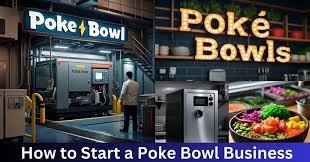Are you passionate about poke bowls and dreaming of turning your love for these delicious dishes into a profitable business venture? Starting a poke bowl business can be an exciting and rewarding endeavor, but it requires careful planning and execution. In this comprehensive guide, we’ll walk you through the steps to launch your very own poke bowl restaurant or food truck, from conducting market research to serving up delicious bowls to your customers.
Understanding the Poke Bowl Craze
Before diving into the nitty-gritty of starting your poke bowl business, let’s take a moment to understand why poke bowls have become such a popular food trend. Originating from Hawaii, poke bowls are a delicious and healthy dish consisting of fresh fish, vegetables, rice or noodles, and an array of flavorful toppings. These customizable bowls appeal to health-conscious consumers looking for nutritious yet satisfying meal options.

Step 1: Conduct Thorough Market Research
The first step in starting any business is to conduct comprehensive market research. This involves analyzing your target market, understanding consumer preferences, and evaluating the competition. Start by identifying your target customers, which may include health-conscious individuals, young professionals, families, fitness enthusiasts, and tourists. Consider factors such as demographics, location, and consumer behavior to tailor your offerings to meet their needs.
Next, research the poke bowl market in your area. Look for existing poke bowl restaurants and food trucks, and analyze their menus, pricing, and customer reviews. Identify gaps in the market where you can differentiate your business and attract customers. Additionally, explore market trends and growth projections to ensure the long-term viability of your venture.
Step 2: Develop a Solid Business Plan
With a clear understanding of the market, it’s time to develop a comprehensive business plan. This document will serve as a roadmap for your poke bowl business and should outline your goals, strategies, and financial projections. Include sections such as:
- Executive Summary: Provide an overview of your business idea and objectives.
- Market Analysis: Summarize your market research findings and identify your target market.
- Menu Development: Outline your poke bowl offerings, including base ingredients, protein options, sauces, and toppings.
- Marketing Strategy: Detail your plans for promoting your business and attracting customers.
- Operations Plan: Describe how your business will operate on a day-to-day basis, including staffing, inventory management, and customer service.
- Financial Projections: Estimate your startup costs, revenue projections, and break-even analysis.
A well-crafted business plan will not only guide your decisions but also attract potential investors and lenders who may provide funding for your venture.
Step 3: Choose the Right Location
The location of your poke bowl business can significantly impact its success. Look for a high-traffic area with plenty of foot traffic, such as busy streets, shopping malls, or office complexes. Consider factors such as proximity to your target market, competition, and accessibility when choosing a location. If you’re opening a brick-and-mortar restaurant, ensure that the space is large enough to accommodate your kitchen equipment and seating area.
Keep in mind that the cost of leasing or renting a commercial space can vary depending on the location and size of the property. Factor these expenses into your budget when selecting a location for your poke bowl business.
Step 4: Source Quality Ingredients and Equipment
One of the keys to a successful poke bowl business is sourcing quality ingredients and equipment. Invest in fresh, sustainable seafood, organic vegetables, and other high-quality ingredients to ensure the best possible taste and nutrition for your customers. Establish relationships with reliable suppliers who can provide consistent quality and timely deliveries.
In addition to ingredients, you’ll also need to invest in commercial kitchen equipment such as refrigeration units, prep tables, knives, and serving bowls. Choose equipment that is durable, efficient, and meets food safety standards to ensure the smooth operation of your kitchen.
Step 5: Build Your Brand Identity
Creating a strong brand identity is essential for attracting customers and setting your poke bowl business apart from the competition. Choose a catchy and memorable business name that reflects the essence of your brand and resonates with your target audience. Design a professional logo and develop a cohesive branding strategy that encompasses your website, social media profiles, and marketing materials.
Consider incorporating unique elements into your brand identity, such as a signature poke bowl recipe or a commitment to sustainability and environmental responsibility. These distinctive features will help differentiate your business and build customer loyalty over time.
Step 6: Market Your Poke Bowl Business Effectively
Once your poke bowl business is up and running, it’s crucial to market it effectively to attract customers and drive sales. Develop a comprehensive marketing strategy that includes both online and offline tactics to reach your target audience.
- Online Marketing: Utilize social media platforms such as Instagram, Facebook, and Twitter to showcase your poke bowl offerings and engage with customers. Consider running paid advertising campaigns to reach a wider audience and drive traffic to your website.
- Offline Marketing: Distribute flyers and brochures in your local community to promote your poke bowl business. Partner with nearby businesses or community organizations to host events or tastings that introduce people to your offerings.
By implementing a multi-channel marketing approach, you can effectively build awareness for your poke bowl business and attract customers from various sources.
Step 7: Provide Exceptional Customer Service
In the competitive food industry, customer service can make or break a business. Strive to provide exceptional service to every customer who walks through your doors or places an order at your food truck. Train your staff to be friendly, knowledgeable, and efficient in serving customers, and encourage them to go above and beyond to ensure customer satisfaction.
Consider implementing loyalty programs or special promotions to reward repeat customers and incentivize them to return to your poke bowl business. By building strong relationships with your customers, you can create a loyal customer base that supports your business for years to come.
Step 8: Monitor and Adapt to Market Trends
Finally, it’s essential to stay informed about market trends and consumer preferences in the poke bowl industry. Monitor changes in the market, such as new ingredient trends, emerging competitors, or shifts in consumer behavior, and be prepared to adapt your business strategy accordingly.
Continuously seek feedback from your customers and evaluate the performance of your poke bowl offerings to identify areas for improvement. By remaining agile and responsive to market dynamics, you can position your poke bowl business for long-term success.
And don’t forget to explore opportunities like the IncFile Fresh Start Business Grant to give your poke bowl business the boost it needs to succeed!
Conclusion
Starting a poke bowl business requires careful planning, dedication, and a passion for providing delicious and healthy meals to your customers. By following the steps outlined in this guide, you can launch your poke bowl venture with confidence and attract a loyal customer base. Remember to stay true to your brand identity, provide exceptional service, and remain adaptable to changes in the market. With perseverance and determination, your poke bowl business has the potential to thrive in this exciting and growing industry.
Frequently Asked Questions (FAQs)
Are poke bowl restaurants profitable?
Yes, poke bowl restaurants can be profitable if managed effectively. The profitability of a poke bowl business depends on various factors such as location, market demand, operational efficiency, and cost management. By conducting thorough market research, offering high-quality ingredients, providing exceptional customer service, and implementing effective marketing strategies, poke bowl restaurants have the potential to generate significant profits.
How do you set up a poke bowl?
Setting up a poke bowl business involves several steps. First, conduct market research to understand your target market and competition. Develop a comprehensive business plan outlining your goals, strategies, and financial projections. Choose an optimal location for your restaurant or food truck. Source quality ingredients and equipment for your kitchen. Build a strong brand identity through effective branding and marketing strategies. Provide exceptional customer service to attract and retain customers. Finally, monitor market trends and adapt your business strategy as needed to ensure long-term success.
Is it cheaper to make your own poke?
Making your own poke bowls at home can be more cost-effective than dining out at a poke bowl restaurant, depending on various factors such as ingredient costs and portion sizes. When preparing poke bowls at home, you have the flexibility to choose ingredients based on your budget and preferences. By purchasing ingredients in bulk and utilizing leftovers, you can further reduce costs. However, it’s essential to consider the time and effort required for preparation and cooking when comparing the overall cost of homemade vs. restaurant poke bowls.
Are homemade Poke bowls healthy?
Homemade poke bowls can be healthy, depending on the ingredients and preparation methods used. Poke bowls typically consist of fresh fish, vegetables, rice or noodles, and toppings such as avocado and seaweed, making them a nutritious meal option. When preparing homemade poke bowls, opt for high-quality, fresh ingredients and avoid excessive use of sauces or dressings high in sodium or sugar. Additionally, consider incorporating a variety of colors and textures to maximize nutritional value. With mindful ingredient selection and portion control, homemade poke bowls can contribute to a balanced and healthy diet.
What type of restaurants make the most money?
The most profitable types of restaurants often include fast food chains, casual dining establishments, and fine dining restaurants. Fast food chains benefit from high volume sales and low operating costs, while casual dining and fine dining restaurants can command higher prices for premium food and dining experiences. Additionally, ethnic cuisine restaurants, food trucks, and franchise operations can also be lucrative depending on market demand and location.
What food restaurants make the most money?
Restaurants that specialize in popular cuisines with broad appeal, such as Italian, American, Chinese, and Mexican, tend to generate the most revenue. Italian restaurants, for example, often offer a variety of pasta dishes, pizzas, and seafood entrees that appeal to a wide range of customers. Similarly, American restaurants may feature burgers, steaks, and comfort food favorites that attract large crowds. By catering to diverse tastes and preferences, these food restaurants can maximize their earning potential.
What is the richest restaurant business in the world?
The richest restaurant business in the world is often subjective and can vary depending on factors such as revenue, brand value, and market capitalization. However, some of the largest and most successful restaurant chains globally include McDonald’s, Starbucks, Subway, KFC, and Pizza Hut. These multinational chains have established a strong presence in numerous countries and consistently generate significant revenue through their diverse menu offerings and expansive customer base.
What is the most successful food business in the world?
The most successful food business in the world encompasses various sectors of the food industry, including fast food, casual dining, fine dining, food manufacturing, and food retail. Companies such as Nestlé, PepsiCo, Coca-Cola, and McDonald’s are among the top-performing players in the global food market, with diversified product portfolios and extensive distribution networks. Additionally, food delivery and meal kit services have experienced rapid growth in recent years, further contributing to the success of the food industry.

